Coupling Coordination Analysis of Urban Development and Ecological Environment in Urban Area of Guilin Based on Multi-Source Data
Abstract
:1. Introduction
2. Study Area and Materials
2.1. Study Area
2.2. Data Resources and Processing
2.2.1. Night-Time Lighting Data
2.2.2. Optical Remote Sensing Images
- (1)
- Greenness indicators
- (2)
- Wetness indicators
- (3)
- Dryness index
- (4)
- Heat index
3. Models and Methods
3.1. NTLI
3.2. RSEI
3.3. CCDM
4. Results and Analysis
4.1. Analysis of Changes in Urban Sprawl
4.2. Ecological Change Analysis
4.3. Analysis of the Coupling and Coordination of Urban Development and Ecological Change
4.4. Urbanization Development and the Continuing Dynamics of Ecological Space
5. Discussions
6. Conclusions
- (1)
- In order to ensure a better construction of the nighttime light index, this paper uses the 2013 monthly NPP/VIIRS and DMSP/OLS data to calibrate and simulate each other to obtain new nighttime light data. It was verified with the historical population (R2 = 0.72) and GDP data (R2 = 0.83). The total number of night lights in 2020 is 7.72 times higher than in 2000. NTLI grew to 0.90, and the urbanization of the urban area of Guilin was significant.
- (2)
- RSEI was constructed to analyze 20 years of ecological changes in the urban area of Guilin through principal component analysis. RSEI increased from 0.45 in 2000 to 0.66 in 2020, with an overall increase in ecological quality. Spatial heterogeneity exists in some areas, mainly reflected in the ecological environment changes in the new and old urban areas. The rapid urban expansion and increased population activities in Lingui District have caused a continuous increase in ecological pressure and a decline in the quality of the ecological environment. On the contrary, some old urban areas, such as Qixing District, have improved ecological quality through urban transformation and greening construction. Among the four indicators, it is easy to find that the greenness and wetness indicators had a catalytic improvement effect on ecology, while dryness and heat had a negative destructive effect.
- (3)
- The interactive relationship between urban development and the ecological environment improved from 2000 to 2020, when the stage of low coordination was transformed into a stage of highly coordinated development. A more delicate CCDM system can more accurately reflect the fine-grained urban-ecological interactions. It is worth noting that from 2013 onwards, the main urban area shifted from lagging urban development to lagging ecology. Since then, urban development has outpaced ecological development and constrained it.
Policy Recommendations
- (1)
- Strengthen the integrated development of urban agglomeration and narrow the internal development differences. From the perspective of urban development, the economy of Lingui District and Yanshan District is lower than that of other districts. Therefore, in terms of existing development elements, the Guilin government should appropriately increase the urban construction of these two districts.
- (2)
- Adhere to the synchronous development of urbanization and ecological environment security. In the process of urban development in some regions, ecological damage has occurred. In the future, the Guilin government should strengthen the ecological protection of these regions. At the same time, we can rely on Guilin’s special tourism culture to develop the service industry to promote economic growth.
Author Contributions
Funding
Institutional Review Board Statement
Informed Consent Statement
Data Availability Statement
Acknowledgments
Conflicts of Interest
Abbreviation
| NTLI | night-time light index |
| RSEI | remote sensing ecological index |
| CCDM | coupling coordination degree model |
| NDVI | normalized difference vegetation index |
| PCA | principal component analysis |
| GEE | Google Earth Engine |
| TNL | total night-time light |
| TCW | tasseled cap wetness |
| NDBSI | normalized difference built-up and soil index |
| LST | land surface temperature |
| IBI | index-based built-up index |
| SI | soil index |
| C | coupling |
| IPD | initial population density |
| GDP | gross domestic product |
References
- Pickett, S.T.A.; Boone, C.G.; McGrath, B.P.; Cadenasso, M.L.; Childers, D.L.; Ogden, L.A.; McHale, M.; Grove, J.M. Ecological science and transformation to the sustainable city. Cities 2013, 32, S10–S20. [Google Scholar] [CrossRef]
- Zhang, X.; Wang, Y.; Qi, Y.; Wu, J.; Liao, W.; Shui, W.; Zhang, Y.; Deng, S.; Peng, H.; Yu, X.; et al. Evaluating the trends of China’s ecological civilization construction using a novel indicator system. J. Clean. Prod. 2016, 133, 910–923. [Google Scholar] [CrossRef]
- Feng, R.; Wang, F.; Wang, K.; Wang, H.; Li, L. Urban ecological land and natural-anthropogenic environment interactively drive surface urban heat island: An urban agglomeration-level study in China. Environ. Int. 2021, 157, 106857. [Google Scholar] [CrossRef] [PubMed]
- He, C.; Gao, B.; Huang, Q.; Ma, Q.; Dou, Y. Environmental degradation in the urban areas of China: Evidence from multi-source remote sensing data. Remote Sens. Environ. 2017, 193, 65–75. [Google Scholar] [CrossRef]
- Hauser, L.T.; Féret, J.-B.; An Binh, N.; van der Windt, N.; Sil, Â.F.; Timmermans, J.; Soudzilovskaia, N.A.; van Bodegom, P.M. Towards scalable estimation of plant functional diversity from Sentinel-2: In-situ validation in a heterogeneous (semi-)natural landscape. Remote Sens. Environ. 2021, 262, 112505. [Google Scholar] [CrossRef]
- Yan, L.; Zhang, X.; Pan, H.; Wu, J.; Lin, L.; Zhang, Y.; Xu, C.; Xu, M.; Luo, H. Progress of Chinese ecological civilization construction and obstacles during 2003–2020: Implications from one set of emergy-based indicator system. Ecol. Indic. 2021, 130, 108112. [Google Scholar] [CrossRef]
- Chen, M.; Sui, Y.; Liu, W.; Liu, H.; Huang, Y. Urbanization patterns and poverty reduction: A new perspective to explore the countries along the Belt and Road. Habitat Int. 2019, 84, 1–14. [Google Scholar] [CrossRef]
- Cui, X.; Fang, C.; Liu, H.; Liu, X. Assessing sustainability of urbanization by a coordinated development index for an Urbanization-Resources-Environment complex system: A case study of Jing-Jin-Ji region, China. Ecol. Indic. 2019, 96, 383–391. [Google Scholar] [CrossRef]
- Zhou, X.; Yang, L.; Gu, X.; Zhang, L.; Li, L. Scarcity Value Assessment of Ecosystem Services Based on Changes in Supply and Demand: A Case Study of the Yangtze River Delta City Cluster, China. Int. J. Environ. Res. Public Health 2022, 19, 11999. [Google Scholar] [CrossRef]
- Destoumieux-Garzon, D.; Matthies-Wiesler, F.; Bierne, N.; Binot, A.; Boissier, J.; Devouge, A.; Garric, J.; Gruetzmacher, K.; Grunau, C.; Guegan, J.F.; et al. Getting out of crises: Environmental, social-ecological and evolutionary research is needed to avoid future risks of pandemics. Environ. Int. 2022, 158, 106915. [Google Scholar] [CrossRef]
- Tang, P.; Huang, J.; Zhou, H.; Fang, C.; Zhan, Y.; Huang, W. Local and telecoupling coordination degree model of urbanization and the eco-environment based on RS and GIS: A case study in the Wuhan urban agglomeration. Sustain. Cities Soc. 2021, 75, 103405. [Google Scholar] [CrossRef]
- Diksha; Kumar, A. Analysing urban sprawl and land consumption patterns in major capital cities in the Himalayan region using geoinformatics. Appl. Geogr. 2017, 89, 112–123. [Google Scholar] [CrossRef]
- Stokes, E.C.; Seto, K.C. Characterizing urban infrastructural transitions for the Sustainable Development Goals using multi-temporal land, population, and nighttime light data. Remote Sens. Environ. 2019, 234, 111430. [Google Scholar] [CrossRef]
- Ali, A.; Alam Nayyar, Z. A Modified Built-up Index (MBI) for automatic urban area extraction from Landsat 8 Imagery. Infrared Phys. Technol. 2021, 116, 103769. [Google Scholar] [CrossRef]
- Huang, C.; Wylie, B.; Yang, L.; Homer, C.; Zylstra, G. Derivation of a tasselled cap transformation based on Landsat 7 at-satellite reflectance. Int. J. Remote Sens. 2010, 23, 1741–1748. [Google Scholar] [CrossRef]
- Li, X.; Elvidge, C.; Zhou, Y.; Cao, C.; Warner, T. Remote sensing of night-time light. Int. J. Remote Sens. 2017, 38, 5855–5859. [Google Scholar] [CrossRef] [Green Version]
- Bennett, M.M.; Smith, L.C. Advances in using multitemporal night-time lights satellite imagery to detect, estimate, and monitor socioeconomic dynamics. Remote Sens. Environ. 2017, 192, 176–197. [Google Scholar] [CrossRef]
- Levin, N.; Kyba, C.C.M.; Zhang, Q.; Sánchez de Miguel, A.; Román, M.O.; Li, X.; Portnov, B.A.; Molthan, A.L.; Jechow, A.; Miller, S.D.; et al. Remote sensing of night lights: A review and an outlook for the future. Remote Sens. Environ. 2020, 237, 111443. [Google Scholar] [CrossRef]
- Krikigianni, E.; Tsiakos, C.; Chalkias, C. Estimating the relationship between touristic activities and night light emissions. Eur. J. Remote Sens. 2019, 52, 233–246. [Google Scholar] [CrossRef] [Green Version]
- Asner, G.P.; Braswell, B.; Schimel, D.S.; Wessman, C.A. Ecological Research Needs from Multiangle Remote Sensing Data. Remote Sens. Environ. 1998, 63, 155–165. [Google Scholar] [CrossRef]
- Hao, J.; Xu, G.; Luo, L.; Zhang, Z.; Yang, H.; Li, H. Quantifying the relative contribution of natural and human factors to vegetation coverage variation in coastal wetlands in China. Catena 2020, 188, 104429. [Google Scholar] [CrossRef]
- Pettorelli, N.; Ryan, S.; Mueller, T.; Bunnefeld, N.; Jedrzejewska, B.; Lima, M.; Kausrud, K. The Normalized Difference Vegetation Index (NDVI): Unforeseen successes in animal ecology. Clim. Res. 2011, 46, 15–27. [Google Scholar] [CrossRef]
- Zhang, C.; Cheng, Y.; He, H.; Gao, L.; Liang, J.; Zhao, X. Structural drivers of biomass dynamics in two temperate forests in China. Ecosphere 2017, 8, e01752. [Google Scholar] [CrossRef]
- Brierley, A.S.; Kingsford, M.J. Impacts of climate change on marine organisms and ecosystems. Curr. Biol. 2009, 19, R602–R614. [Google Scholar] [CrossRef] [PubMed] [Green Version]
- Niroumand-Jadidi, M.; Bovolo, F.; Bruzzone, L. Water Quality Retrieval from PRISMA Hyperspectral Images: First Experience in a Turbid Lake and Comparison with Sentinel-2. Remote Sens. 2020, 12, 3984. [Google Scholar] [CrossRef]
- Painii-Montero, V.F.; Santillán-Muñoz, O.; Barcos-Arias, M.; Portalanza, D.; Durigon, A.; Garcés-Fiallos, F.R. Towards indicators of sustainable development for soybeans productive units: A multicriteria perspective for the Ecuadorian coast. Ecol. Indic. 2020, 119, 106800. [Google Scholar] [CrossRef]
- Xu, H.; Wang, M.; Shi, T.; Guan, H.; Fang, C.; Lin, Z. Prediction of ecological effects of potential population and impervious surface increases using a remote sensing based ecological index (RSEI). Ecol. Indic. 2018, 93, 730–740. [Google Scholar] [CrossRef]
- Yue, H.; Liu, Y.; Li, Y.; Lu, Y. Eco-Environmental Quality Assessment in China’s 35 Major Cities Based on Remote Sensing Ecological Index. IEEE Access 2019, 7, 51295–51311. [Google Scholar] [CrossRef]
- Cai, J.; Li, X.; Liu, L.; Chen, Y.; Wang, X.; Lu, S. Coupling and coordinated development of new urbanization and agro-ecological environment in China. Sci. Total Environ. 2021, 776, 145837. [Google Scholar] [CrossRef]
- Xu, D.; Yang, F.; Yu, L.; Zhou, Y.; Li, H.; Ma, J.; Huang, J.; Wei, J.; Xu, Y.; Zhang, C.; et al. Quantization of the coupling mechanism between eco-environmental quality and urbanization from multisource remote sensing data. J. Clean. Prod. 2021, 321, 128948. [Google Scholar] [CrossRef]
- Ariken, M.; Zhang, F.; Liu, K.; Fang, C.; Kung, H.-T. Coupling coordination analysis of urbanization and eco-environment in Yanqi Basin based on multi-source remote sensing data. Ecol. Indic. 2020, 114, 106331. [Google Scholar] [CrossRef]
- Amani, M.; Ghorbanian, A.; Ahmadi, S.A.; Kakooei, M.; Moghimi, A.; Mirmazloumi, S.M.; Moghaddam, S.H.A.; Mahdavi, S.; Ghahremanloo, M.; Parsian, S.; et al. Google Earth Engine Cloud Computing Platform for Remote Sensing Big Data Applications: A Comprehensive Review. IEEE J. Sel. Top. Appl. Earth Obs. Remote Sens. 2020, 13, 5326–5350. [Google Scholar] [CrossRef]
- Li, X.; Li, D.; Xu, H.; Wu, C. Intercalibration between DMSP/OLS and VIIRS night-time light images to evaluate city light dynamics of Syria’s major human settlement during Syrian Civil War. Int. J. Remote Sens. 2017, 38, 5934–5951. [Google Scholar] [CrossRef]
- Goward, S.N.; Xue, Y.; Czajkowski, K.P. Evaluating land surface moisture conditions from the remotely sensed temperature/vegetation index measurements. Remote Sens. Environ. 2002, 79, 225–242. [Google Scholar] [CrossRef]
- Lobser, S.E.; Cohen, W.B. MODIS tasselled cap: Land cover characteristics expressed through transformed MODIS data. Int. J. Remote Sens. 2007, 28, 5079–5101. [Google Scholar] [CrossRef]
- Crist, E.P. A TM Tasseled Cap equivalent transformation for reflectance factor data. Remote Sens. Environ. 1985, 17, 301–306. [Google Scholar] [CrossRef]
- Huang, H. Study on the Quality Development of New Urbanization with Chinese Characteristics; China Statistics Press: Beijing, China, 2020; pp. 30–32. [Google Scholar]
- Baig, M.H.A.; Zhang, L.; Shuai, T.; Tong, Q. Derivation of a tasselled cap transformation based on Landsat 8 at-satellite reflectance. Remote Sens. Lett. 2014, 5, 423–431. [Google Scholar] [CrossRef]
- Xu, H. A new index for delineating built-up land features in satellite imagery. Int. J. Remote Sens. 2008, 29, 4269–4276. [Google Scholar] [CrossRef]
- Rikimaru, A.; Roy, P.S.; Miyatake, S. Tropical forest cover density mapping. Trop. Ecol. 2002, 43, 39–47. [Google Scholar]
- Chander, G.; Markham, B.L.; Helder, D.L. Summary of current radiometric calibration coefficients for Landsat MSS, TM, ETM+, and EO-1 ALI sensors. Remote Sens. Environ. 2009, 113, 893–903. [Google Scholar] [CrossRef]
- Small, C.; Elvidge, C.D.; Balk, D.; Montgomery, M. Spatial scaling of stable night lights. Remote Sens. Environ. 2011, 115, 269–280. [Google Scholar] [CrossRef]
- Wang, J.; Liu, H.; Liu, H.; Huang, H. Spatiotemporal Evolution of Multiscale Urbanization Level in the Beijing-Tianjin-Hebei Region Using the Integration of DMSP/OLS and NPP/VIIRS Night Light Datasets. Sustainability 2021, 13, 2000. [Google Scholar] [CrossRef]
- Shen, L.; Huang, Y.; Huang, Z.; Lou, Y.; Ye, G.; Wong, S.-W. Improved coupling analysis on the coordination between socio-economy and carbon emission. Ecol. Indic. 2018, 94, 357–366. [Google Scholar] [CrossRef]
- Tian, Y.; Zhou, D.; Jiang, G. Conflict or Coordination? Multiscale assessment of the spatio-temporal coupling relationship between urbanization and ecosystem services: The case of the Jingjinji Region, China. Ecol. Indic. 2020, 117, 106543. [Google Scholar] [CrossRef]
- Xie, X.; Sun, H.; Gao, J.; Chen, F.; Zhou, C. Spatiotemporal Differentiation of Coupling and Coordination Relationship of Tourism–Urbanization–Ecological Environment System in China’s Major Tourist Cities. Sustainability 2021, 13, 5867. [Google Scholar] [CrossRef]
- Gao, L.; Tao, F.; Liu, R.; Wang, Z.; Leng, H.; Zhou, T. Multi-scenario simulation and ecological risk analysis of land use based on the PLUS model: A case study of Nanjing. Sustain. Cities Soc. 2022, 85, 104055. [Google Scholar] [CrossRef]
- Liu, T.-Y.; Su, C.-W. Is transportation improving urbanization in China? Socio-Econ. Plan. Sci. 2021, 77, 101034. [Google Scholar] [CrossRef]


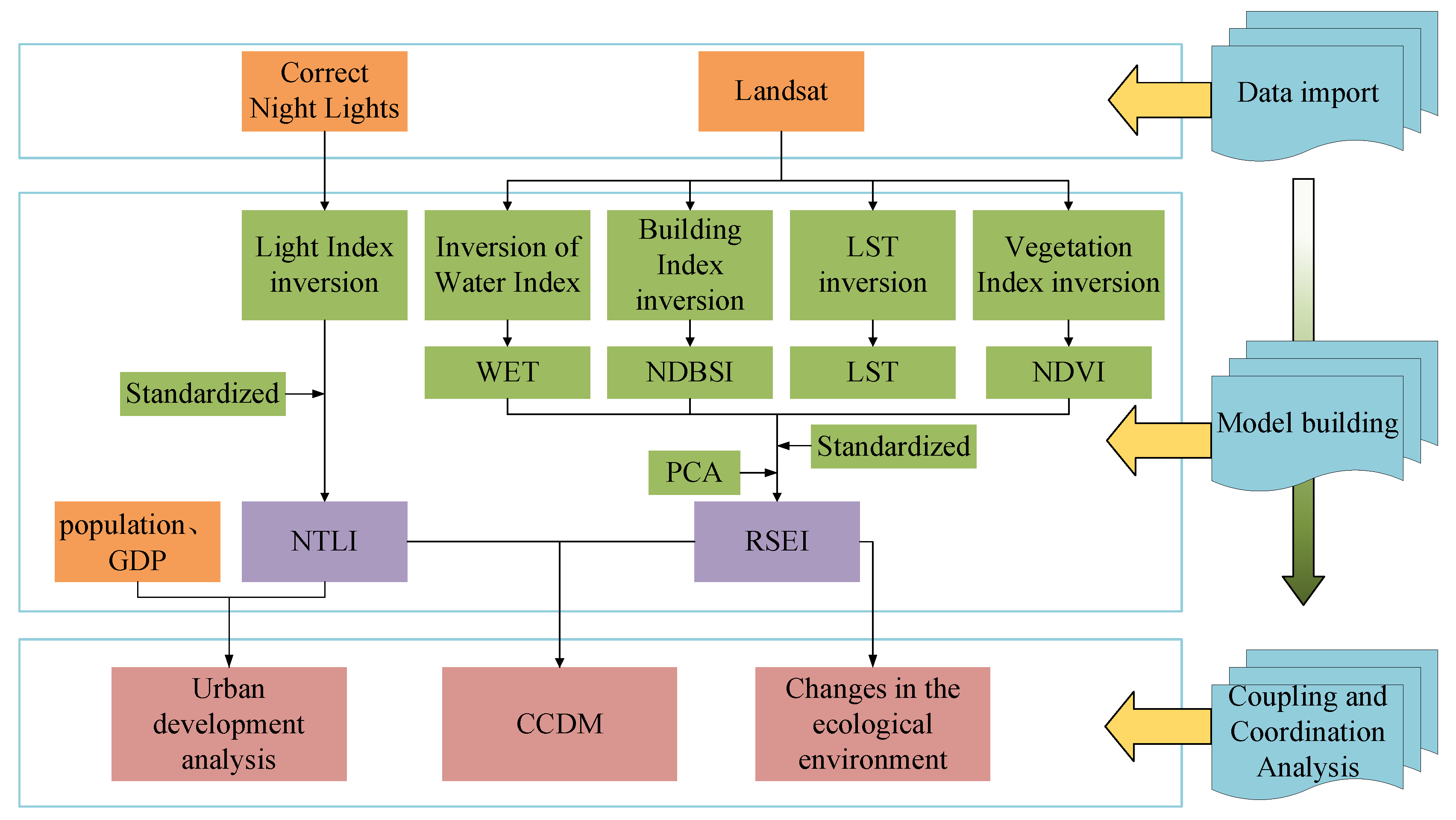
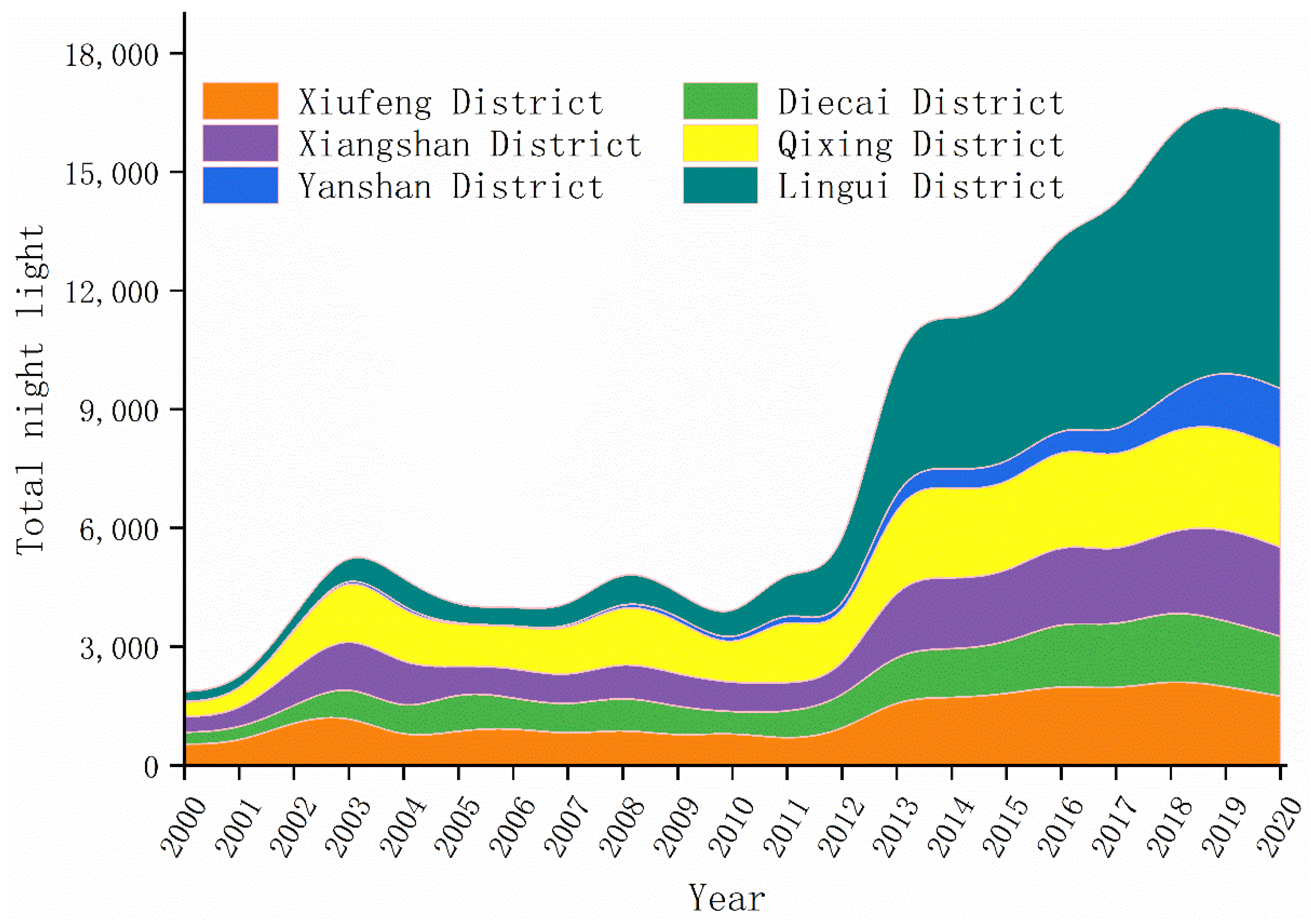

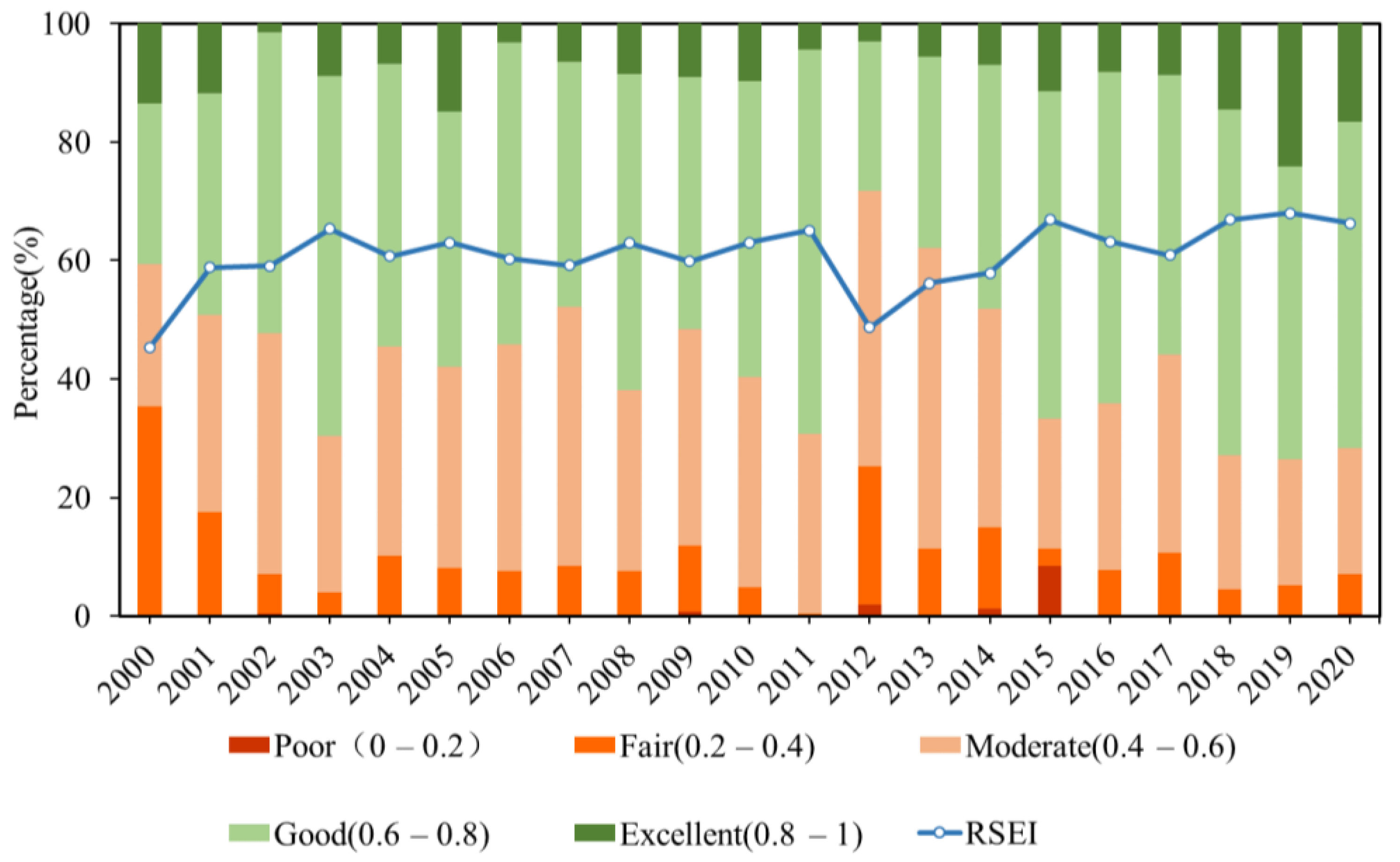
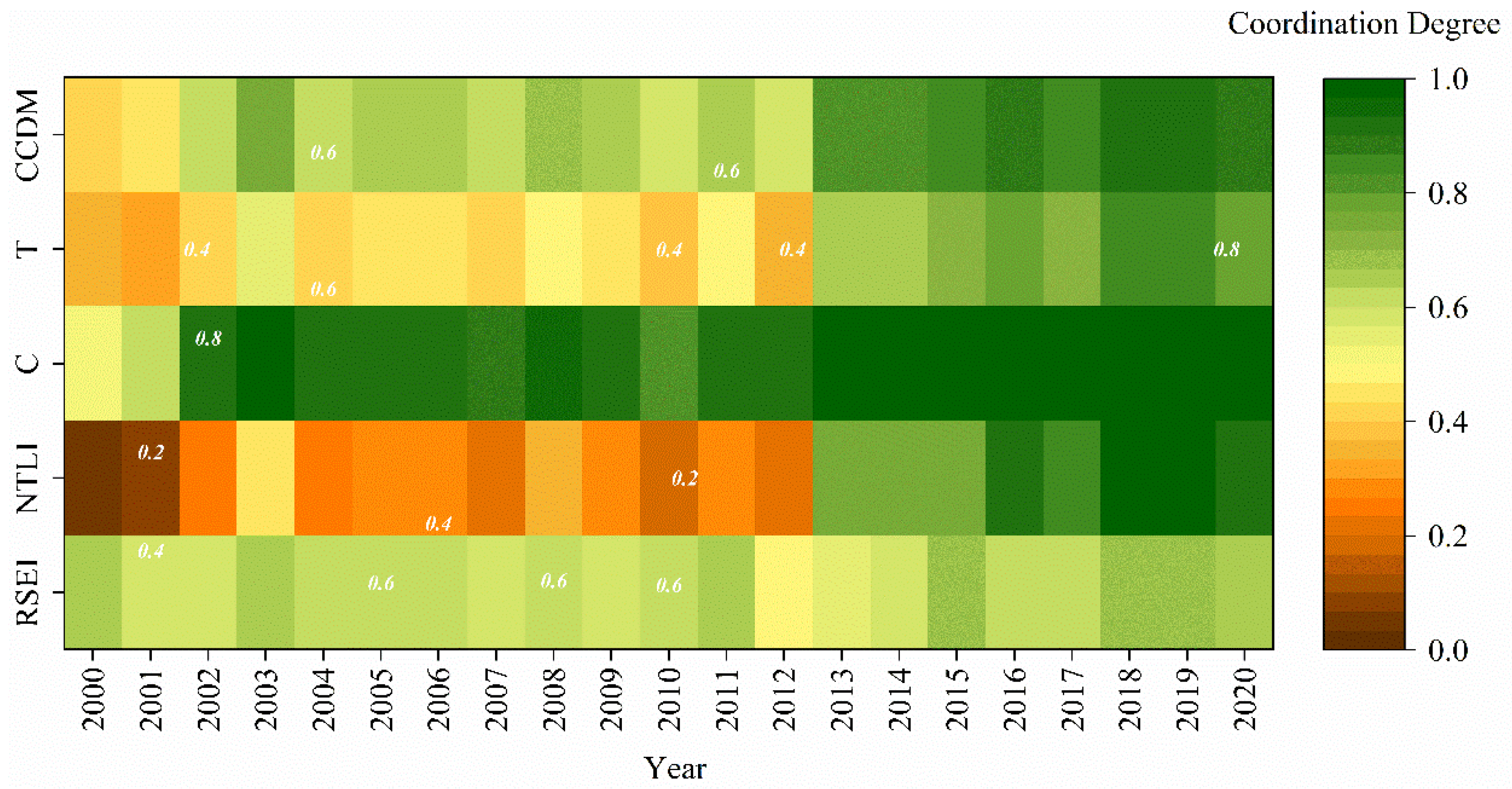
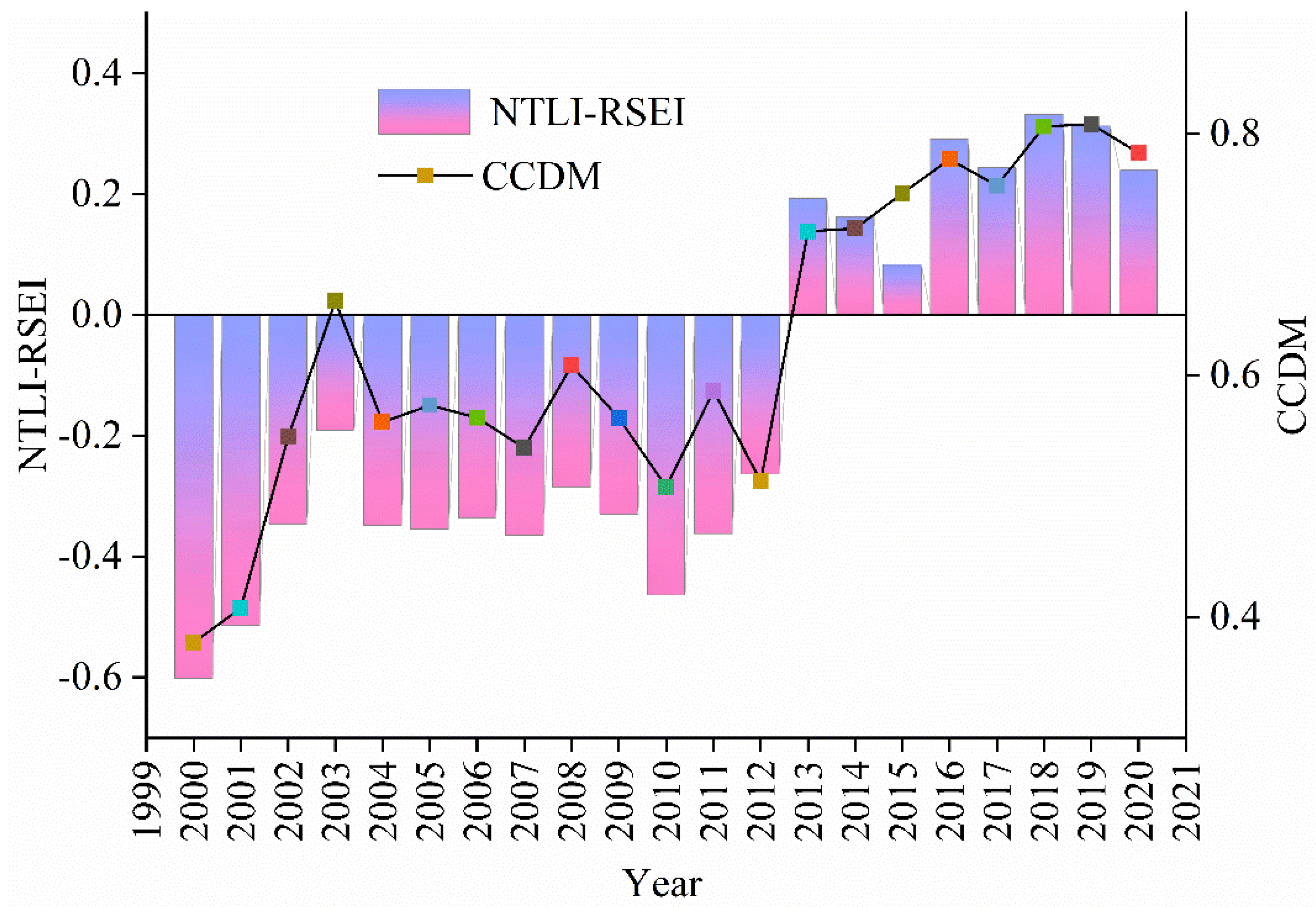

| Sensor | Blue | Green | Red | Nir | Swir1 | Swir2 |
|---|---|---|---|---|---|---|
| TM | 0.0315 | 0.2021 | 0.3102 | 0.1594 | −0.6806 | −0.6109 |
| ETM | 0.1509 | 0.1973 | 0.3102 | 0.1594 | −0.6806 | −0.6109 |
| OLI | 0.1511 | 0.1973 | 0.3283 | 0.3407 | −0.7117 | 0.4559 |
| CCDM Level | Subcategory Coordination | Systematic Exponential Comparison | Subcategory |
|---|---|---|---|
| 0 ≤ CCDM ≤ 0.4 | Low level of coordination | NTLI-RSEI > 0.1 | Ecologically lagging |
| |NTLI-RSEI| < 0.1 | Urban development and ecological synchronization | ||
| NTLI-RSEI < −0.1 | Urban development lagging | ||
| 0.4 ≤ CCDM ≤ 0.65 | Moderate coordination | NTLI-RSEI > 0.1 | Ecologically lagging |
| |NTLI-RSEI| < 0.1 | Urban development and ecological synchronization | ||
| NTLI-RSEI < −0.1 | Urban development lagging | ||
| 0.65 ≤ CCDM ≤ 1.0 | Highly coordinated | NTLI-RSEI > 0.1 | Ecologically lagging |
| |NTLI-RSEI| < 0.1 | Urban development and ecological synchronization | ||
| NTLI-RSEI < −0.1 | Urban development lagging |
| Year | IPD (People/km2) | GDP per Capita (¥) | Urbanization Rate(%) | Light Density at Night |
|---|---|---|---|---|
| 2000 | 369 | 11,095.37 | 21.34 | 1.05 |
| 2001 | 382 | 12,282.15 | 21.80 | 1.11 |
| 2002 | 389 | 13,352.32 | 22.22 | 2.16 |
| 2003 | 397 | 14,516.69 | 22.57 | 3.16 |
| 2004 | 404 | 16,499.46 | 22.72 | 2.22 |
| 2005 | 411 | 19,035.93 | 22.95 | 2.30 |
| 2006 | 415 | 21,815.50 | 24.50 | 2.27 |
| 2007 | 421 | 26,026.88 | 23.63 | 2.08 |
| 2008 | 482 | 26,782.80 | 24.13 | 2.61 |
| 2009 | 484 | 28,704.59 | 23.94 | 2.27 |
| 2010 | 497 | 32,986.76 | 23.71 | 1.81 |
| 2011 | 503 | 37,831.78 | 23.58 | 2.36 |
| 2012 | 514 | 40,980.08 | 23.56 | 2.06 |
| 2013 | 522 | 45,453.81 | 23.45 | 4.48 |
| 2014 | 528 | 48,483.94 | 22.54 | 4.42 |
| 2015 | 537 | 51,051.46 | 30.51 | 4.47 |
| 2016 | 544 | 54,561.44 | 31.48 | 5.25 |
| 2017 | 551 | 51,640.27 | 33.37 | 4.94 |
| 2018 | 555 | 52,634.04 | 35.55 | 5.60 |
| 2019 | 558 | 57,415.71 | 48.13 | 5.57 |
| 2020 | 605 | 53,021.99 | 50.90 | 5.16 |
| Indicators | 2000 | 2010 | 2020 | |||
|---|---|---|---|---|---|---|
| Eigenvalue | Contribution Rate/(%) | Eigenvalue | Contribution Rate/(%) | Eigenvalue | Contribution Rate/(%) | |
| PC1 | 0.3775 | 97.16 | 0.3659 | 95.15 | 0.3824 | 95.94 |
| PC2 | 0.0048 | 98.40 | 0.0136 | 98.69 | 0.0125 | 99.08 |
| PC3 | 0.0036 | 99.33 | 0.0040 | 99.73 | 0.0032 | 99.88 |
| PC4 | 0.0026 | 100.0 | 0.0010 | 100.0 | 0.0005 | 100.0 |
| Statistical Values | 2000 | 2010 | 2020 | |||
|---|---|---|---|---|---|---|
| Average | Standard | Average | Average | Average | Standard | |
| NDVI | 0.457 | 0.166 | 0.264 | 0.239 | 0.688 | 0.157 |
| TCW | 0.670 | 0.060 | 0.695 | 0.067 | 0.151 | 0.050 |
| NDBSI | 0.022 | 0.085 | 0.011 | 0.041 | 0.151 | 0.050 |
| LST | 0.403 | 0.055 | 0.856 | 0.124 | 0.274 | 0.079 |
| RSEI | 0.652 | 0.074 | 0.630 | 0.414 | 0.698 | 0.663 |
| Category | Class | 2000–2004 | 2005–2010 | 2011–2015 | 2016–2020 | 2000–2020 |
|---|---|---|---|---|---|---|
| Worse | −4 (km2) | 2.0 (0.08%) | 1.0 (0.04%) | 2.7 (0.1%) | 4.4 (0.2%) | 1.1 (0.04%) |
| −3 (km2) | 12.4 (0.5%) | 12.1 (0.5%) | 17.7 (0.7%) | 12.2 (0.5%) | 16.2 (0.6%) | |
| −2 (km2) | 61.2 (2.4%) | 34.2 (1.4%) | 55.4 (2.2%) | 24.5 (1.0%) | 51.6 (1.8%) | |
| −1 (km2) | 396.5 (15.6%) | 232.1 (9.2%) | 212.9 (8.4%) | 186.9 (7.4%) | 129.6 (4.4%) | |
| Unchanged | 0 (km2) | 1489.8 (59.1%) | 976.6 (38.7%) | 1582.1 (62.7%) | 1015.1 (40.2%) | 1105.3 (37.9%) |
| Better | 1 (km2) | 478.6 (18.9%) | 1140.7 (45.2%) | 554.5 (21.9%) | 951.5 (37.7%) | 691.7 (23.7%) |
| 2 (km2) | 64.5 (2.6%) | 109.3 (4.3%) | 81.7 (3.2%) | 271.4 (10.7%) | 457.2 (15.7%) | |
| 3 (km2) | 16.1 (0.6%) | 12.6 (0.5%) | 13.4 (0.5) | 43.3 (1.7%) | 457.2 (15.7%) | |
| 4 (km2) | 1.4 (0.06%) | 3.9 (0.2%) | 2.1 (0.08%) | 13.3 (0.5%) | 11.0 (0.4%) |
Publisher’s Note: MDPI stays neutral with regard to jurisdictional claims in published maps and institutional affiliations. |
© 2022 by the authors. Licensee MDPI, Basel, Switzerland. This article is an open access article distributed under the terms and conditions of the Creative Commons Attribution (CC BY) license (https://creativecommons.org/licenses/by/4.0/).
Share and Cite
Liu, T.; Ren, C.; Zhang, S.; Yin, A.; Yue, W. Coupling Coordination Analysis of Urban Development and Ecological Environment in Urban Area of Guilin Based on Multi-Source Data. Int. J. Environ. Res. Public Health 2022, 19, 12583. https://doi.org/10.3390/ijerph191912583
Liu T, Ren C, Zhang S, Yin A, Yue W. Coupling Coordination Analysis of Urban Development and Ecological Environment in Urban Area of Guilin Based on Multi-Source Data. International Journal of Environmental Research and Public Health. 2022; 19(19):12583. https://doi.org/10.3390/ijerph191912583
Chicago/Turabian StyleLiu, Taolin, Chao Ren, Shengguo Zhang, Anchao Yin, and Weiting Yue. 2022. "Coupling Coordination Analysis of Urban Development and Ecological Environment in Urban Area of Guilin Based on Multi-Source Data" International Journal of Environmental Research and Public Health 19, no. 19: 12583. https://doi.org/10.3390/ijerph191912583
APA StyleLiu, T., Ren, C., Zhang, S., Yin, A., & Yue, W. (2022). Coupling Coordination Analysis of Urban Development and Ecological Environment in Urban Area of Guilin Based on Multi-Source Data. International Journal of Environmental Research and Public Health, 19(19), 12583. https://doi.org/10.3390/ijerph191912583







